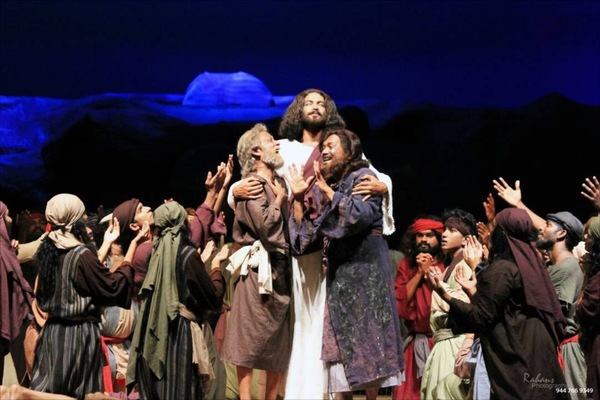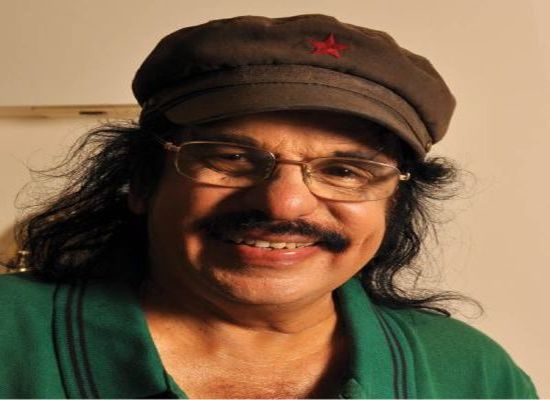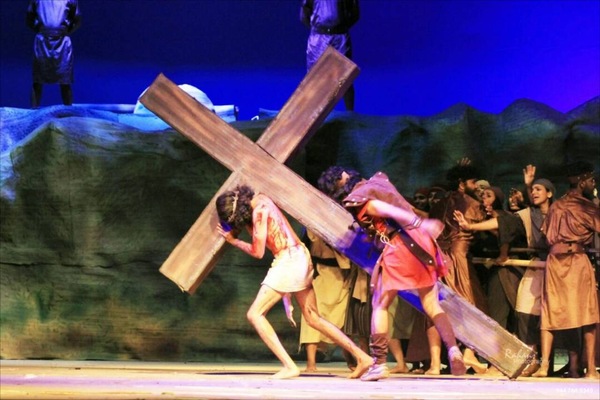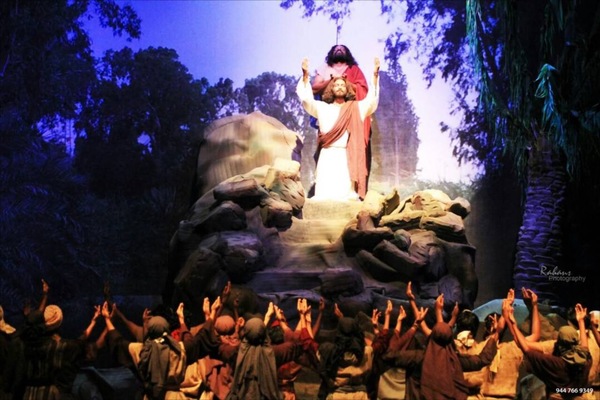01/05/2017
During this Easter Lent season, I had the great fortune to watch a memorable event conceptualized by noted cultural activist Soorya Krishnamoorthy. An engineer, philanthropist and founder of Soorya Stage and Film Society, Krishnamoorthy has been penning and staging plays for many years. This time he raised the bar exceptionally high with a light and sound stage show on the life of Jesus Christ. The ambitious two hour show titled Ente Rakshakan (My Savior) boasted of a massive cast of 150 characters and 50 animals and birds in a specially erected stage in 20 cents of land at the St. Mary’s school ground in Thiruvananthapuram. It was brought to life by the concerted efforts of Changanassery Sargakshetra, Mar Chrysostom World Peace Foundation and Soorya Theatre and generously financed by 20 producers, most of them NRIs. A fabulous crew including lyricist Prof. V. Madhusoodhanan Nair, music composer Pandit Ramesh Narayanan and make-up man Pattanam Rasheed worked behind it. The stagecraft and direction is by Krishnamurthy himself. The show is expected to be around for some years and I would recommend it to all art lovers, irrespective of their religious persuasion.
The show is laudable for attempting a syncretism of faiths. After we are told that at the beginning there was the Word, the reverberating chant of omkara (Aum sound) and Sanskrit verses follow. Jesus faces the audience when he brings Lazarus from the dead, a metaphor for spiritual awakening of people. The song in the scene where Christ discourses on the Water of Life to the Samaria woman at the well is evocative of Kumaran Asan’s Chandalabhikshuki or Tagore’s Chandalika, a poem and play respectively based on Buddhist tales. Christ’s compassionate attitude toward Mary Magdalene reminds one of Upagupta and Vasavadatta, again of Buddhist lore.
Buddhism indeed has much to do with what I am going to state next. The most brilliant part of the show for me, lasting hardly a few moments, comes soon after the scenes of the boy Jesus at the synagogue in Nazareth. As we know, there is a yawning gap in the New Testament concerning the life of Jesus for eighteen long years starting from his twelfth year. On stage the screen lights up with a few visuals of the majestic Himalayan peaks while a cryptic caption displays the words ‘Himalayas, India’. And quickly enough the scene shifts to a 30-year-old and wiser Jesus, ready to receive baptism from John and to embark on his public ministry. Maybe the creators of the show let go of the opportunity to explore the India sojourn of Christ so as not to disappoint the ecclesiastical. Or it was not deemed relevant in a show which anyway compressed a humongous amount of material into a two hour time capsule. The story went by the book for the most part. But we must laud the director for his gesture of giving India and Eastern philosophies their due, albeit as a fleeting hint. After all Will Durant in his seminal work, The Story of Civilizations, had described the scriptures of India as ‘the oldest extant philosophy and psychology of our race’ (Volume I - Our Oriental Heritage).
Why did Matthew, Mark, Luke and John who wrote the canonical gospels that shed light on the life of Jesus Christ leave out more than half his lifetime? Were their hands forced? Or did an erasure happen later on? The dogmatism that the Orthodox Church with its many variants came to embody hardly went with the grain of the mystic’s teachings. The teachings of Christ, as those of any enlightened Master ought to be, were about inner realization. The idea of intermediaries on the path to salvation from sins was likely not in his agenda. The clergy wanted to keep Jesus distinctly different from the common man by giving him a divine halo, yet Jesus himself had told Thomas, author of the Gnostic Gospel, that they have both ‘received their being from the same source’. This identity of divine and human is at the core of Eastern philosophy. But the vested interests of the West hardly ever acknowledged the greatness of the East in any sphere of thinking. As Holger Kersten, the German theologian and Orientalist who wrote the best-selling book ‘Jesus Lived in India’ in 1981 lamented, scholarly scrutiny in the search for the historical Jesus met with religious resistance and the reasons are not hard to guess. Kersten was inspired by the findings of a few great men for nearly a century preceding his research.
The first person to put forth the theory that Jesus lived in India was the Russian journalist Nikolai Alexandrovich Notovitch in 1887. Staying in Kashmir and Ladakh, Notovitch met an abbot at a Tibetan monastery in Hemis in Leh who told him about the visit of a certain ‘Issa’ from Jerusalem. The Russian was set to return to Kashmir when his knee broke due to a fall from a horse. It proved to be a boon as he was invited to stay in the lamasery and get treatment from the monks. During the time he could persuade them to let him make copies of manuscripts confirming the visit of Christ and later wrote about it in the Russian edition book ‘The Life of Saint Issa.’ Edward T. Martin’s book ‘King of Travelers: Jesus' Lost Years in India’ is a pursuit of these claims. Isha, the name used in the original Pali script, could’ve been the one given to Jesus by the Wise Men from the East who visited him at his birth. Since the word, derived from Ishvara, means Lord or Master, Jesus is often addressed as Lord. Two men who at later points in the ‘20s went to the places in the Himalayan region mentioned by Notovitch are Swami Abhedananda (1866 – 1939), a direct disciple of Sri Ramakrishna Paramahamsa who was heading for Tibet and artist, and archeologist Nicholas Roerich (1874 – 1947). Both have attested to the veracity of the findings. Later Kersten went to Dharamsala to research and got a copy of the document signed by the Dalai Lama.
Joseph wanted his son Jesus to get the best education in the world from Nalanda University and sent him along with merchants who traced the silk route to India. Jesus reached Sind via Turkey, Persia, Europe, and Afghanistan and studied the Vedas under Brahmin pandits at Puri. He lost interest in their ritualistic practices. He visited the mystical order of Nath Yogis who have preserved a Sutra called Natha Namavali which talks of him as the saint Isha Nath. He spent six years with the Sakya Buddhist sect in the Himalayan mountain regions of Nepal and Tibet. After some years of preaching in Asia he returned to Jerusalem via Persia at the age of 30. It was in India that he acquired his yogic powers and initiation to the esoteric science of self-realization through meditation. He was crucified at Calvary but was able to survive death. The spiritual master Meher Baba (1894 – 1969) explains that Christ did not die on the cross but went into Nirvikalpa Samadhi or ‘I am God state without bodily consciousness.’ On the third day he regained consciousness of his body and travelled with the apostles Bartholomew and Thaddeus secretly to India. He went to Rangoon and proceeded to Kashmir where he settled down. He taught the people there who venerated him as a great prophet and reformer. After finishing his work on earth he dropped his body and attained Samadhi. His body is buried in a cave near a place called Harvan. However this was disputed by Mirza Ghulam Ahmad, founder of the Ahmadiyya movement who claimed in his Urdu treatise ‘Masih Hindustan Mein’ that the Jesus had assumed the name Yuz Asaf while staying in India and that his tomb is the Roza Bal shrine in Srinagar.
Gautama Buddha who predated Jesus by five centuries had performed the kind of miracles that Jesus was to emulate later. Telepathy, clairvoyance, astral travel, psycho kinesis and such parapsychology phenomena have been achieved by several people through breath control and deep mind relaxation techniques. A good book for insights into the power of yogis, one that Steve Jobs read for every year for the last forty years of his life, is ‘Autobiography of a Yogi’ by Paramahansa Yogananda. There are yogis in the Himalayas who can go without food or water for years together, levitate, live for a few hundred years, etc. Nirvikalpa Samadhi is the highest form of Samadhi where mental activity merges in the Self such that the distinction between knower and known object dissolves away. Swami Rama talks about witnessing levitation in his book ‘Living with the Himalayan Masters.’ Sri M, author of ‘Apprenticed to a Himalayan Master’ mentions a vision he had while meditating in the sublime peaks in which past Masters came to him and one of them was Jesus Christ. The legend of Krishna predates Christ by 3,000 years. The similarities in the lives of the two men starting with their names are too striking to ignore. Like the boy Jesus in the apocryphal gospels Krishna too performed miracles.
There are similarities to Christ with the legend of Dionysus/ Bacchus of 8th century BC as well. In his impressive two volume commentary ‘The Second Coming of Christ: The Resurrection of the Christ within you,’ Yogananda elucidates the original teachings of Jesus. He states at the outset, ‘There is a distinguishing difference of meaning between Jesus and Christ. His given name was Jesus; his honorific title was Christ. In his little human body called Jesus was born the vast Christ Consciousness, the omniscient Intelligence of God omnipresent in every part and particle of creation. This Consciousness is the “only begotten Son of God” so designated because it is the sole perfect reflection in creation of the Transcendental Absolute, Spirit or God the Father.’ In light of this wisdom a better title than My Savior for a work on the life of the mystic would be My Guide (Ente Vazhikatti). But pragmatism often ensures that the enquiring artist end up as, pardon the pun, a cross between a seeker and a believer.
In 1986, a Malayalam play ‘Christuvinte Aaram Thirumurivu’ by P.M. Antony kicked up a row in Kerala with the church calling for its ban. It sparked off debates about intellectual freedom as well. The play, based on Nikos Kazantzakis’s 1955 Greek novel The Last Temptation of Christ, depicted Christ as an ordinary carpenter in Nazareth who came to do extraordinary feats. On the cross he dreams about marrying Mary Magdalene and raising a family. He soon overcomes the dream and the temptation. The sixth sacred wound that the play talks about is that of the heart. An eponymous film was made on the novel by Martin Scorsese in 1988. These works chose to fill the gap in the Bible story by portraying Christ as a carpenter in Galilee in the lost years. There are several other versions of his life in the mysterious period including one that says that he went to England. Then there are those advocates of symbology who hold that the physical person of Christ is a myth and that the stories surrounding him are but cleverly veiled metaphors for sun worship.
Jesus Christ, one of the greatest saints to have walked on earth, falls within the pantheon of Occidental seekers who went to the Orient in search of deeper meaning, some of them later joining the public discourse while others chose to pursue the path of solitude. His life teaches us to realize the God within us, because all living beings are made in the image of God. Soorya Krishnamoorthy’s Bible Mega Show resoundingly drives home the message.




